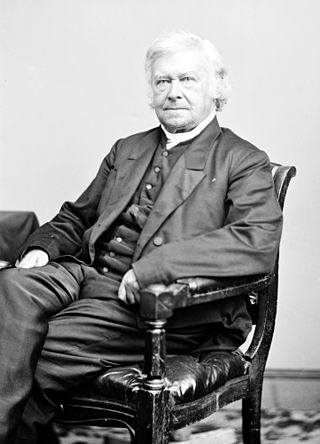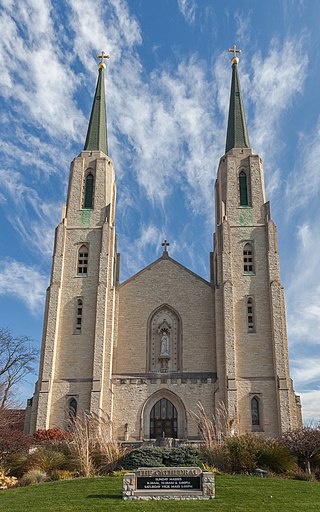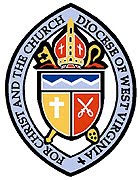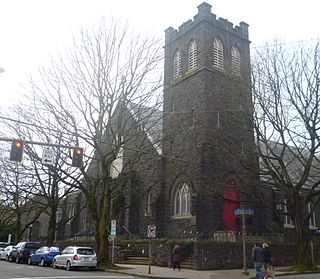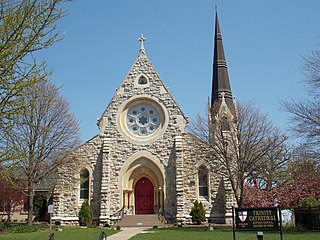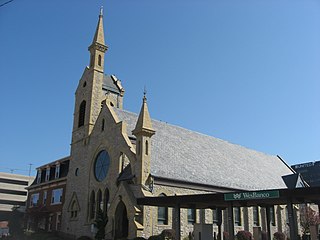Trinity Episcopal Church | |
 | |
| Location | 611 West Berry Street, Fort Wayne, Indiana |
|---|---|
| Coordinates | 41°4′40″N85°8′52″W / 41.07778°N 85.14778°W |
| Area | less than one acre |
| Built | 1865 |
| Architect | C.C. Miller |
| Architectural style | Gothic Revival |
| NRHP reference No. | 78000044 [1] |
| Added to NRHP | September 13, 1978 |
Trinity Episcopal Church is a historic Episcopal congregation and church, designed by Toledo, Ohio architect Charles Crosby Miller and constructed ca. 1865 in Fort Wayne, Indiana. The congregation was organized in 1839 as Christ Church and the name changed in 1844 to Trinity Church. The first church was built on the southeast corner of Berry and Harrison Streets in 1848. [2] It is an example of Gothic Revival architecture. [3]
Contents
It was listed on the National Register of Historic Places in 1978. [1]
HISTORY
The Rt. Rev. Jackson Kemper, Bishop of the Northwest, visited Fort Wayne for the first time in 1837 in an effort to organize a church. Two years later, he set the Rev. Benjamin Hutchins, formerly of Philadelphia, to organize a church, and Christ Episcopal Church was formally established on May 26, 1839. The congregation languished when Hutchins departed soon after, and in 1844, Peter P. Bailey, a businessman from New York City, began offering lay readings from the Book of Common Prayer. Bishop Kemper sent another missionary, the Rev. Benjamin Halsted, and on May 25, 1844, Trinity Episcopal Church was formally organized. After meeting initially in the Allen County Courthouse, the church raised funds for a wood framed chapel at the southeast corner of Berry and Harrison. (The present historical marker is inaccurate about its location).
In 1863, the vestry called the Rev. Joseph S. Large to lead an effort to build a new Gothic Revival Church under a design by Charles Crosby Miller of Toledo, Ohio. After many delays and financial shortfalls, the building was completed in the fall of 1866 and consecrated two years later by the Rt. Rev. Joseph C. Talbot, Bishop Coadjutor of Indiana.
Trinity Church has had the following rectors:
Rev. Benjamin Halsted, 1844-1846
Rev. Joseph S. Large, 1848-1854
Rev. Caleb Alexander Bruce, 1854-1855
Rev. Eugene Charles Pattison, 1856-1858
Rev. Stephen Henry Battin, 1858-1863
Rev. Joseph S. Large, 1863-1872
Rev. Colin Campbell Tate, 1872-1879
Rev. William Naylor Webbe, 1879-1888
Rev. Alexander Washington Seabrease, 1888-1904
Rev. Edward Wilson Averill, 1904-1923
Rev. Louis Niccola Rocca, 1923-1930
Rev. Charles Noyes Tyndell, 1931-1932
Rev. James McNeal Wheatley, 1932-1947
Rev. George Bartlett Wood, 1947-1971
Rev. Chandler Corydon Randall, 1971-1988
Rev. Frank Hazlett Moss III, 1990-1999
Rev. Rebecca Ferrell Nickel, 2001-2004
Rev. Thomas Parker Hansen, 2006-2016
Rev. T. J. Freeman, 2017-
In 1955-1956, a large classroom building was added to the church to serve the needs of the growing parish. The church was added tot he National Register of Historic Places in 1973.


